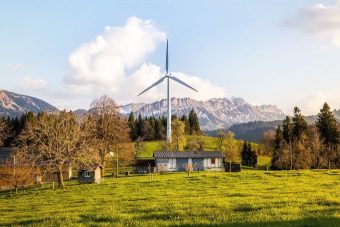
From the fertile spud-growing country of Hepburn Shire, 90km northwest of Melbourne, has sprung what many hope will become a revolution in renewable energy in Australia.
On Leonards Hill, just outside the town of Daylesford – famed for its natural springs – stand two wind turbines that not only power the local area, but have also added substantial power to the community-owned renewable energy movement in Australia.
The turbines, cheesily called Gusto and Gale, constitute the very first community-owned windfarm in Australia. It borrows the idea from a long tradition of community-owned power that was forgotten in Australia, but lives on strongly in Denmark.
“In Denmark there’s over 2,100 versions of this,” says Taryn Lane, the community manager for Hepburn Wind, the cooperative that owns and operates the windfarm. “Their model – this way of owning your own energy generator locally – emerged in the late 70s, so they have been doing it for decades.”
It was at a community meeting for a large corporate-owned windfarm, like the one near Hepburn, that the idea for Hepburn Wind emerged.
Strong community opposition, often encouraged by the fossil fuel industry, has at times been a roadblock for large windfarms built by traditional energy companies.
Lane says the Danish founder of Hepburn Wind, Per Bernard, attended the meeting with a few people from Daylesford, and they saw the community express a lot of opposition to one of those projects.
“They were quite disappointed that that was our local area’s first response to large-scale renewables development in the area,” Lane says.
Bernard figured that if they adopted the Danish model, where the windfarm was smaller, and the local community owned it, support for clean, clean wind energy would grow.
The idea of communities owning their own power generators is not new in Australia, according to Lane, it’s just been forgotten. That was the way electricity was first introduced into much of the country, with smaller decentralised generators, owned by the local communities.
The mayor of Hepburn Shire, Sebastian Klein agrees. “Hepburn actually used to own its own power generating sources. We used to have our own generator in the main street of Daylesford [and] we used to have our own hydro station down at the lake,” he says.
“So for people it was quite an obvious step that we might be able to take back the power so to speak.”
Lane says: “It’s ironic now that there is this broader push back to that more decentralised system.”
And Bernard turned out to be right. Hepburn Wind began construction in 2010 and started selling power in 2011. And the group had overwhelming local support. “We are a cooperative of 2,007 members,” says Lane. “They’ve contributed just under $10m.”
The majority of the investors are from the local region, something the cooperative has written into its rules.
Paul Howden is one of them. As with most investors in community-owned renewable energy, his motivations were a mix of hard-nosed financial ones, and the desire to do a bit of good. “Partly, obviously because it’s a renewable energy project,” he says, explaining his investment. “But also because we thought it was a good and wise investment for our super fund.
“This is a win-win for both the environment [and] the community.”
One of the things that made him confident that the project was a good investment, he says, was the level of community support it received, and the passion of the people running it.
But beyond the construction of the 4.1MW windfarm – enough to power about 2,300 households – Hepburn Wind pioneered the modern large-scale community-ownership model of renewable energy in Australia, which is now being replicated around the country.
Simon Holmes à Court was the founding chairman of Hepburn Wind. And after spending years developing a model that worked, and navigating the various logistical potholes in getting it up and running, he set up Embark, a non-profit company dedicated to helping other community energy projects adopt the Hepburn model.
Several projects around the country have received advice and support from Embark, including Pingala, which gathered locals in Sydney’s Newtown to build a solar array on the top of a brewery, and the Sydney Renewable Power Company, which recently built Australia’s largest CBD solar farm.
But back in Hepburn shire, not satisfied with the windfarm, the residents are expanding the renewables in their area.
By a picturesque lake in Daylesford, where locals go to swim and cool off, is an antique hydro generator, which used to power a few homes around the lake, and the lake’s lights. “It kept the lake area electrified,” says Lane.
It was shut down in 1934, and has lain dormant ever since. But Hepburn Wind cooperative figured they could refurbish it, and pour even more clean energy into the grid.
In February, that was made possible when the energy retailer that buys Hepburn Wind’s electricity – Powershop – announced it had crowdfunded more than $100,000 for community-owned renewable energy projects, and one project that would receive a slice of it was Hepburn Wind’s hydro project.
“The original size was 13kWs or just under,” says Lane. “And we will look to somewhere between there and maybe up to 40kWs if we can put a side-by-side motor next to it.”
She says that will be enough to power about eight to 12 houses – not a huge amount, but it’s an easy win.
And with Hepburn shire adding its name to a growing list of councils shooting to reduce their emissions to zero, every bit counts. Says Lane: “At Hepburn Wind we really want to play our role in helping our community reach zero net emissions.”
Source: theguardian.com
Photo: inhabitat.com





